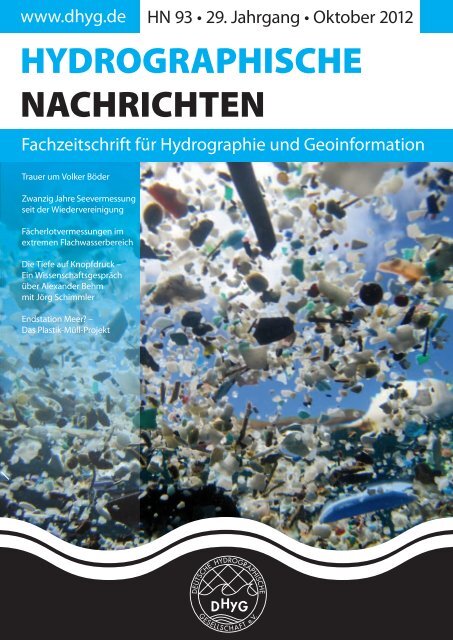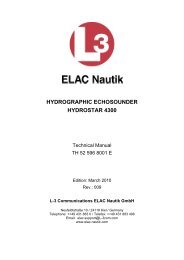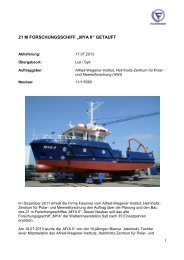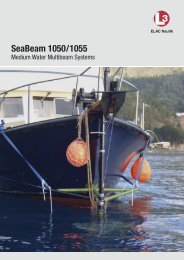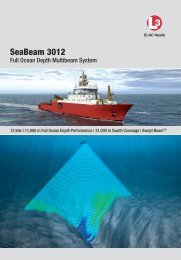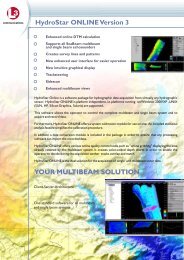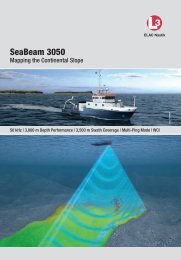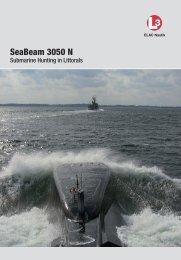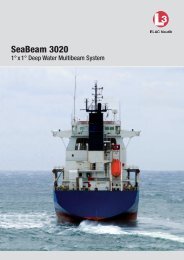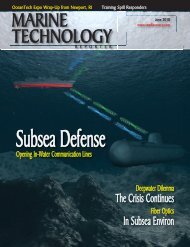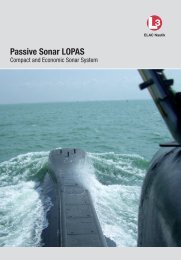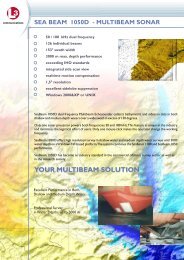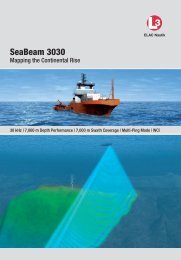Hydrographische Nachrichten - Elac-Nautik
Hydrographische Nachrichten - Elac-Nautik
Hydrographische Nachrichten - Elac-Nautik
Create successful ePaper yourself
Turn your PDF publications into a flip-book with our unique Google optimized e-Paper software.
www.dhyg.de<br />
HN 93 • 29. Jahrgang • Oktober 2012<br />
HYDROGRAPHISCHE<br />
NACHRICHTEN<br />
Fachzeitschrift für für Hydrographie und Geoinformation<br />
Trauer um Volker Böder<br />
Zwanzig Jahre Seevermessung<br />
seit der Wiedervereinigung<br />
Fächerlotvermessungen im<br />
extremen Flachwasserbereich<br />
Die Tiefe auf Knopfdruck –<br />
Ein Wissenschaftsgespräch<br />
über Alexander Behm<br />
mit Jörg Schimmler<br />
Endstation Meer? –<br />
Das Plastik-Müll-Projekt
<strong>Nachrichten</strong> — 10-2012 — HN 93<br />
James Cameron’s undersea voyage<br />
With L-3 ELAC <strong>Nautik</strong> into the Mariana Trench<br />
An article by Ulrike Schulte-Rahde<br />
On March 26, 2012, at 7:25 a.m. Mr. Cameron<br />
touched bottom at a depth of 10 898 metres and<br />
stayed there for several hours in order to explore,<br />
film and collect scientific samples.<br />
The Mariana Trench is the most remote and isolated<br />
place on the planet. To meet the extraordinary<br />
demands of the expedition, L-3 was tasked<br />
with providing a technical solution that would enable<br />
Mr. Cameron and his submarine’s systems to<br />
remain in contact through voice and digital communications<br />
to the surface at all times. L-3’s underwater<br />
communications solution included the<br />
MASQ signalling system from L-3 Nautronix complemented<br />
by the UT 3000 underwater telephone<br />
system from L-3 ELAC <strong>Nautik</strong>.<br />
The dive was the centrepiece of the DEEPSEA<br />
CHALLENGE expedition, a joint scientific project<br />
by James Cameron, the National Geographic Society<br />
and Rolex to conduct deep-ocean research<br />
and exploration. The information collected during<br />
the expedition will be included in a National<br />
Geographic magazine story as well as a 3-D feature<br />
documentary film to be released this winter.<br />
»We are extremely proud to have been part of<br />
James Cameron’s historic expedition and to have<br />
assured reliable communications to the bottom<br />
of the ocean«, said Paul Roberts, L-3 Nautronix<br />
project manager and expedition team member.<br />
»This project proves that the possibilities for voice<br />
For his latest film project James Cameron was attracted once again by ocean depth.<br />
The enthusiastic oceanographer has already absolved more than 70 deep sea diving<br />
operations in preparation for blockbusters such as Titanic (1997) and Abyss of Death<br />
(1989). His latest endeavour, however, dwarfed everything that has been ventured till<br />
Underwater communication | L-3 ELAC <strong>Nautik</strong> | James Cameron | Mariana Trench | Deepsea Challenger | Nautile<br />
and digital data transfer now have few limitations.<br />
The L-3 solution guaranteed the continuous flow<br />
of information, allowing Mr. Cameron to immediately<br />
transmit the news of his landing on the<br />
Trench to the expedition’s surface vessels, as well<br />
as his wife, and to simultaneously receive their<br />
congratulations.«<br />
L-3 Nautronix’ MASQ signalling system was<br />
developed to provide next-generation, reliable<br />
Through Water Communications (TWC) as an underwater<br />
SMS-style messaging system operating<br />
at speed and depth. L-3 ELAC <strong>Nautik</strong>’s UT 3000 is<br />
a premier underwater communications system<br />
that combines analogue and digital communication<br />
in a single unit. In addition to a telephony and<br />
telegraphy mode, the UT 3000 provides unique<br />
features, such as own noise measurement, horizontal<br />
distance measurement and transmission of<br />
SOS signals.<br />
Aside from underwater communications, the<br />
state-of-the-art systems supported the monitoring<br />
of critical data, including Mr. Cameron’s vital<br />
signs, the submarine’s oxygen and battery levels,<br />
depth, speed, and range from the support vessels.<br />
Michael Sieger, L-3 ELAC <strong>Nautik</strong>’s Technical Manager<br />
Underwater Communication Systems, spent<br />
two weeks on site the expedition to support the<br />
DEEPSEA CHALLENGE team with the installation of<br />
the underwater communication system UT 3000,<br />
this day. With his mini<br />
sub »Deepsea Challenger«,<br />
specially developed<br />
for this mission during<br />
seven years of preparation,<br />
he ventured to<br />
the Mariana Trench, the<br />
deepest point on earth.<br />
Author<br />
Ulrike Schulte-Rahde is<br />
Marketing Manager at<br />
L-3 ELAC <strong>Nautik</strong> GmbH in Kiel.<br />
Contact:<br />
ulrike.schulte-rahde@L-3com.com<br />
»Deepsea Challenger«<br />
with modems<br />
37<br />
James Cameron and Paul Roberts<br />
in front of the UT 3000 and<br />
SeaBeam map of the Mariana Trench
HN 93 — 10-2012 — <strong>Nachrichten</strong><br />
38<br />
Links:<br />
www.deepseachallenge.com<br />
http://flotte.ifremer.fr/fleet/<br />
Presentation-of-the-fleet/<br />
Underwater-systems/<br />
Nautile/#domaine<br />
tests and other training on the job tasks. Mr. Sieger<br />
knows the UT 3000 by heart as he initiated it in<br />
2004 and since then he not only works on its development,<br />
he also constantly finds new applications<br />
for the well proven system. »Besides being<br />
very proud to have been a part of such an amazing<br />
project, I was deeply impressed by James Cameron<br />
who not only was very friendly and charismatic, he<br />
also knew a lot about all technical details and set<br />
his hands to the installation.«<br />
After the successful cooperation between the<br />
sister companies L-3 Nautronix and L-3 ELAC <strong>Nautik</strong><br />
that lead to the solution used for the DEEPSEA<br />
CHALLENGE, Michael Sieger looks forward to find<br />
even more fields of application for it. He says that<br />
this is only the beginning of a wide range of different<br />
scientific projects where the UT 3000 and the<br />
modems can be used for after having delivered a<br />
brilliant performance in such an exceptional project.<br />
Another example of a scientific application of<br />
the underwater communication system is a project<br />
that started two years ago when the UT 3000 has<br />
been installed on Ifremer’s (French Research Institute<br />
for Exploration of the Sea) AUV »Nautile«. The<br />
manned submarine has been designed for observing<br />
and operating at depths reaching 6000 metres<br />
with application areas from exploration of specific<br />
zones, high precision bathymetry and physical<br />
measurements, collecting samples and manipulating<br />
special tools, assistance for offshore assignments,<br />
cable and pipeline layouts and inspection,<br />
assistance for submersibles in distress, search, location,<br />
investigation and assistance in raising wrecks<br />
to operation on polluting wrecks and therefore<br />
requires reliable communication to the surface as<br />
well as the possibility to collect and send precious<br />
data during its missions.<br />
The close network between Ifremer and L-3<br />
ELAC <strong>Nautik</strong> is a good example for the ideal cooperation<br />
between science and economy as ELAC<br />
also benefits by constantly getting information<br />
on the performance of its underwater communication<br />
system that helps to find new application<br />
fields and to optimise the system.<br />
Dealing with the Mariana Trench is literally not<br />
being in uncharted waters for L-3 ELAC <strong>Nautik</strong>. Its<br />
Seabeam deep water multi-beam systems have<br />
already been used to explore the deepest point<br />
on earth before. The detailed charts of the Challenger<br />
Deep that have been produced during<br />
bathymetric surveys by R/V »Kairei« (Japan Agency<br />
for Marine-Earth Science and Technology) in 1998,<br />
1999 and 2002 by using a 12 kHz multi-beam echosounder<br />
have been used to prepare for Cameron’s<br />
expedition.<br />
»By preparing the DEEPSEA CHALLENGE exploration<br />
using charts that have been processed from<br />
data collected with our deepwater multi-beam systems<br />
we’ve come to full circle«, says Dr. Peter Gimpel,<br />
Director Survey Systems at L-3 ELAC <strong>Nautik</strong>.<br />
COMMUNICATE YOUR MISSION<br />
Underwater Communication System UT 3000<br />
The UT 3000 is the latest version of underwater communication<br />
systems designed and built by L-3 ELAC <strong>Nautik</strong>. The system is a<br />
milestone in the history of underwater communication as it offers<br />
proven digital data transmission for the fi rst time.<br />
Besides being already installed on an increasing number of submarines<br />
and surface ships worldwide and therefore well-proven<br />
even under harsh conditions, the system offers various options for<br />
scientifi c applications and is the ideal partner for all underwater<br />
missions that need reliable communication to the surface and the<br />
possibility to collect and send data.<br />
A large display offers an unbeaten intuitive operation and variety<br />
of features as telephony, telegraphy, digital data transmission<br />
and reception, noise measurement, distance measurement and<br />
emergency mode. The online and offl ine BITE supports an uninterrupted<br />
availability of the system.<br />
Up to four transducer groups are supported for directional or<br />
omni-directional transmission within the widest frequency range<br />
available on the market.<br />
Learn more about the UT 3000 at Hydro12, Booth No. L6!<br />
www.elac-nautik.com


